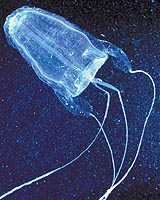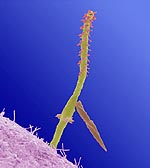 How to recognize Hawaiian box jellyfish How to recognize Hawaiian box jellyfish
 Treatment for box jellyfish stings Treatment for box jellyfish stings
 Health Calendar Health Calendar
By Katherine Nichols
Advertister Staff Writer
They’re called Carybdea alata and measure only 4 by 2 by 2 inches. But that meant little to University of Hawai‘i biochemist Angel Yanagihara when she was stung by a swarm of Hawaiian box jellyfish while swimming off Kaimana Beach in 1997.
 |
| This is the Carybdea alata, a Hawaiian box jellyfish. The effects of its stings sometime last for months.
Courtesy Waikiki Aquarium |
Within an hour, severe breathing difficulties required emergency resuscitation. Doctors treated her with anti-inflammatory agents and pain relievers that helped only minimally. The pain left her bedridden for two days. A persistent rash itched for 14 weeks. What was in this terrible venom? Yanagihara was more than a little motivated to find out.
After conducting a literature search, Yanagihara, who began her doctoral studies in neuroscience at Georgetown and finished at the University of Hawai‘i, said she found only one report that briefly documented the box jellyfish’s effects on the skin, and no information about the biochemical composition of its venom, nor possible immunological responses associated with stings.
Yanagihara decided that she had found her new specialty.
Thousands of people in the Islands have endured experiences similar to (though often less severe than) Yanagihara’s. Most local folks know that Hawaiian box jellyfish appear eight to 10 days after a full moon, but much about the animals remains a mystery. Why do they follow this lunar cycle? Why are their stings so painful? And what’s being done to find effective treatments?
Funding by the Hawai‘i Community Foundation and NIH have enabled Yanagihara to study the topic for the past three years. One goal of Yanagihara’s five-member international research team at the Bekesy Laboratory of Neurobiology at the University of Hawai‘i is to find an antidote for the pain and sometimes months-long tingling sensations and itchy welts that Hawaiian box jellyfish stings can inflict. She said that by identifying the "biochemical nature of active components of the venom," figuring out how they can be inactivated, and clarifying how each part produces its effects on sting victims, their data have already provided significant evidence from which clinical treatments could be designed.
 |
| Tiny tubules, a quarter-millimeter in length, are covered with venom and spines that penetrate the skin, causing the pain and swelling associated with jellyfish stings.
Dennis Kunkel • Bekesy Laboratory of Neurobiology |
As yet, however, those treatments have not been clinically tested.
The closest living relative of the Hawaiian box jellyfish is the Australian box jellyfish, whose venom can kill an adult within 10 minutes. But there have been no reports of deaths from Hawaiian box jellyfish stings.
Hawaiian box jellyfish live at 10-60 feet below sea level off O‘ahu’s leeward coasts (there is little data from other islands) because that’s where the majority of their food supply — plankton — exists. It’s also why divers often get stung; this is the same territory they tend to explore.
Relatively new research has determined that eight to 10 days after a full moon, jellyfish swim purposefully (up to two miles per hour using jet propulson) toward and along the shore to spawn between midnight and 4 a.m. Why? Yanagihara thinks they’re less likely to encounter predators in the shallow water .
She also speculates that the reason they frequent O‘ahu’s beaches is because they are attracted to the lights of populated areas. Once they become beached, the jellyfish cannot survive. Most are eaten rapidly by sand crabs.
Stings on contact
When it’s alive, no part of the jellyfish is safe to touch. The bell and tentacles contain stinging cells. Each stinging cell has one nematocyst, a bulb-like structure which is composed of a capsule, tubule, spines (fish hooks) and venom. With contact, it takes only a few microseconds for the nematocyst to fire — the most rapid, explosive biological event ever recorded. It’s an effective defense: even if the jellyfish has been washed ashore and dismembered, the nematocysts still fire.
Yanagihara said that skin rashes from box jellyfish stings can last up to 10 months in some cases, which surpasses the response one would expect from even the most potent venom (from which you either die or recover). This, Yanagihara theorized, "strongly suggests the presence of persistent foreign matter under the skin."
An electron micrograph helped confirm this theory. Each tentacle, which can grow to about 12 inches long in the Hawaiian box jellyfish, is covered with what appear to be spines surrounding each needle-like tubule. In essence, a sting is the equivalent of getting poked with a million microscopic hypodermic needles — with fishhooks all around them.
The bottom line: "You want to remove the tentacle immediately from the skin, and you don’t want to rub it," said Yanagihara. Sting victims at the beach should take care to lift the pink, foot-long, stringy tentacles from the skin with a stick or other object (not with bare hands!), as nematocysts fire from all sides.
According to Dr. Craig Thomas, an emergency medicine specialist at Castle and Wahiawa hospitals, and author of "All Stings Considered" (University of Hawai‘i Press, 1997), dousing the wound with meat tenderizer can actually do more harm than good, because some people are allergic to tenderizer. Other popular remedies, including the homey favorite, urine, can also be harmful, and alcohol is downright dangerous. Yanagihara confirmed that any kind of alcohol will induce almost 100 percent of the nematocysts to fire.
"There really are two issues: what you should do with venom that’s on the skin, and how to minimize the severity of the reaction to the venom that injected in you," said Thomas. "Once the venom’s in there, there’s not much you can do about it. Nobody has died in Hawai‘i; everybody gets better eventually." In his opinion, the goal in treatment should be to "do no harm."
Heat findings
Yanagihara’s lab research discovered that the "principle hemolytic toxin in this complex venom is inactivated by heat." But this doesn’t mean a hot pack from the microwave will rid your body of the toxins. She’s talking about 45 degrees Celsius, or 113 degrees Fahrenheit, for 20 minutes.
Thomas acknowledged the value of this research, but said, unfortunately, "that doesn’t mean it’s clinically useful. You can’t do 45 degrees (C) without causing tissue damage."
Yanagihara agreed, and said she would like to investigate combination therapies based her lab data that would be more applicable for human use.
Something else that lab research has shown will inhibit toxin and limit hemolysis — the breakdown of blood cells that causes inflammation, pain, and blood pressure changes — are certain simple sugars found in active yogurt cultures. Another possible solution for sting victims: a hot yogurt pack on the wound? In fact, the application of sugars might allow a reduction in the applied heat. It makes sense based on the lab data, said Yanagihara, but she is quick to point out that no clinical research has been conducted on this theory.
Vinegar helps
Thomas recently completed a study on victims in conjunction with Hawai‘i city and county lifeguards; it will be published in an upcoming issue of the Hawai‘i Medical Journal. The research examines the effects of heat and ice on stings. "What (the study) showed was not much, to be honest," he said. "It showed no clear advantage to either heat or cold."
The first thing Thomas does for box jellyfish sting victims is flush the wound with household vinegar. Then, "based on our studies, I would feel comfortable offering a heat pack," he said. "If that helped, fine. If not, I would offer a cold pack. If they needed pain medication, I would offer that, too."
Yanigahara said that household vinegar "stabilizes the toxin, because it has not been chemically inactivated." It may inhibit the firing of nematocysts temporarily, she said, but the activity will resume.
What it does do, said Thomas, is "minimize the chance of further harm while you’re getting the tentacles off the body." Both agreed vinegar will do nothing for pain. But it will buy time.
When cleaning the affected area, it was once thought that fresh water would cause more nematocysts to fire because it’s foreign to the jellyfish, but that theory "has no scientific backing" said Thomas.
He said to wash the area with either salt water or fresh water. The eye area, especially, should always be flushed with plenty of fresh water.
Yanagihara noted that studying the composition of the venom may have positive implications beyond helping sting victims.
"Understanding how venom works sheds light on how other neurodegenerative diseases work," she said. This could mean clinical implications for understanding and treating heart disease or asthma.
[back to top] |

 The Great Index to Fun
The Great Index to Fun
